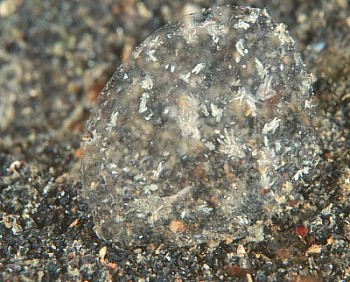
Favorinus sp. 3
Order: NUDIBRANCHIA
Suborder: AEOLIDINA
Family: Glaucidae
PHOTO
Many animals in polychaete worm egg case. Lembeh Strait, North Sulawesi, Indonesia. Photo: Denise Nielsen Tackett.
See message and photos below.
Authorship detailsRudman, W.B., 2000 (July 16) Favorinus sp. 3 [In] Sea Slug Forum. Australian Museum, Sydney. Available from http://www.seaslugforum.net/find/favosp3
Related messages
Re: Nudi in a Bubble
April 19, 2010
From: Tony Wu
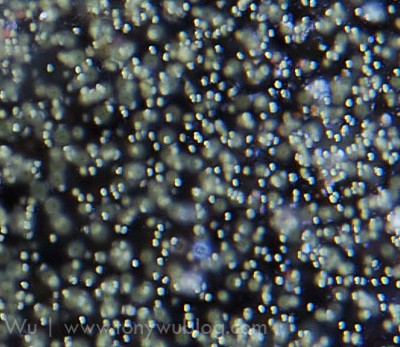
Concerning message #23512:
Hi Bill,
I read your note on the forum. For what it's worth, I looked through my other photos, and it doesn't appear as if the eggs are strung together like nudibranch eggs. For reference, here is a crop at 100% view:
And here is another one (also at 100% magnification), with the white eggs that I think belong to the nudibranch included for comparison:
If these photos help you in any way, please feel free to use them. Or let me know if there's anything else that might be useful.
Cheers,
Tony
tony@tony-wu.com
Wu, T., 2010 (Apr 19) Re: Nudi in a Bubble. [Message in] Sea Slug Forum. Australian Museum, Sydney. Available from http://www.seaslugforum.net/find/23517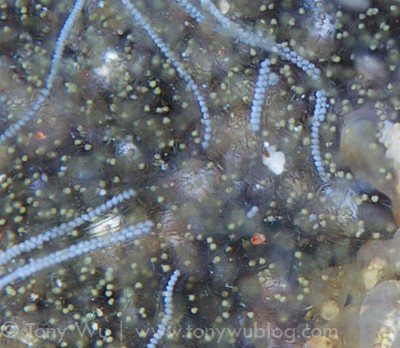
Dear Tony,
Thanks for your quick response. The lack of a 'string' linking the eggs together suggest a polychaete to me but Cory Pittman's observations [message #21552] showing that some cephalaspideans, like Atys sp. and Diniatys sp. have randomly arranged eggs, make a simple answer difficult.
Concerning the ownership of the larger white eggs in strings. Although we don't seem to have direct evidence, I noticed similar strings in an earlier message [#22593], and like you I am pretty sure they belong to the aeolid.
Best wishes,
Bill Rudman
Re: Nudi in a Bubble
April 19, 2010
From: Tony Wu
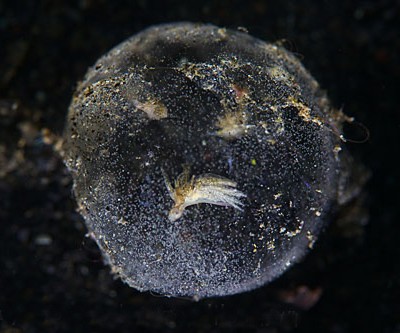

Concerning message #22593:
Here are some more photos from Lembeh of the same type of situation, with the aeolid nudibranchs feeding on the eggs, and also possibly laying eggs of their own.
More description here:
http://www.tonywublog.com/20100418/aeolid-nudibranchs-eating-eggs-of-polychaete-worms.html
Locality: Lembeh Strait (Batu Sandar and Jahir), 7-15 metres, Indonesia, 14 March 2010, 15 March 2010, Muck. Length: 2mm to 15mm. Photographer: Tony Wu.
Tony Wu.
www.tonywublog.com
tony@tony-wu.com
Wu, T., 2010 (Apr 19) Re: Nudi in a Bubble. [Message in] Sea Slug Forum. Australian Museum, Sydney. Available from http://www.seaslugforum.net/find/23512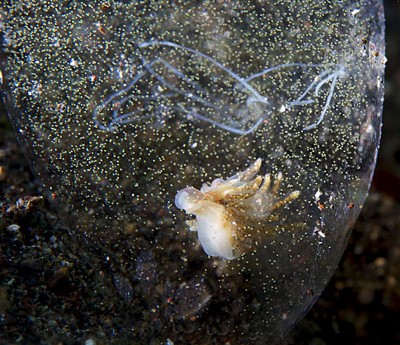
Thanks Tony,
It will be interesting to discover just who made the eggs this nudibranch is eating. I suggested early on that they look like polychaete eggs but in other messages it has been suggested they are most likely the eggs of shelled cephalaspidean 'slugs'. The reason I suspected they were worm eggs were because the individual eggs seem to be scatterd at random rather than being arranged in strings which is what opisthobranchs do. I am not sure whether your original photos can show such microscopic detail but it would be nice to see if there is a 'string' linking the eggs to one another in a single row
Best wishes,
Bill Rudman
Nudi in a Bubble
September 30, 2009
From: Jeff Davies

Hi Bill,
Yesterday we found an area of about 1 m square with several small Nudi's inside bubbles of what I think is algea - I've attached a picture of the Nudi inside and a second with a little more detail of an individual outside.
Can you identify the Nudi, and do you know why they seem to like riding inside the bubbles?
Locality: Magic Crack, Lembeh Strait, 10 m, North Sulawesi, Indonesia, Celebes Sea, 29 July 2009, Black "Muck" Volcanic Sand. Length: 6-8 mm. Photographer: Jeff Davies.
Thanks
Jeff Davies
jeffrey_davies@hotmail.com



Dear Jeff,
There are some sea slugs which live in and feed on bubble-shaped algae [see Ercolania kencolesi] but they are all herbivorous sacoglossans. Your animal is a carnivorous aeolid nudibranch, whihc usually feed on hydroids. However yours is one of a small group which feeds on the eggs of other sea slugs, and sometimes the egg of polychaete worms.
I am pretty sure your animal is what I am calling Favorinus sp. 3 on the Forum. As you will see from other comments of mine on the Forum it is possible that this is not a species of Favorinus but that is the only group of aeolids which we know feed on eggs.
I have also included a closeup showing parts of a string of larger eggs which I suspect are the eggs of your aeolid. If so that is an interesting find
Best wishes,
Bill Rudman
Re: Favorinus sp. 3 ? from East Timor
July 21, 2008
From: Brian Francisco
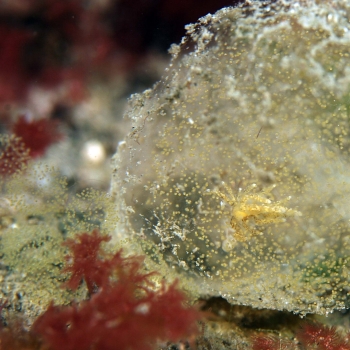
Concerning message #21700:
Hi Bill
I should have remembered Ayumi Murakami's messages from April regarding Favorinus. It just didn't occur to me that the eggs didn't belong to the aeolid. The dive site where this was found is scattered with spent egg sacks and other membrane-like structures. And at the time, it seemed that one of these had simply rolled over and engulfed the aeolid and its eggs, trapping them together.
I've cleaned up another photo from the dive (very silty) which shows adjacent egg sacks, but unfortunately no detail of the second aeolid.
Locality: Sandy Bottom, 14 metres, East Timor, Banda Sea, 13 July 2008, sandy slope. Length: 5 mm. Photographer: Brian Francisco.
As usual, thanks for the information.
Brian
francisco.brian@gmail.com
Francisco, B., 2008 (Jul 21) Re: Favorinus sp. 3 ? from East Timor. [Message in] Sea Slug Forum. Australian Museum, Sydney. Available from http://www.seaslugforum.net/find/21711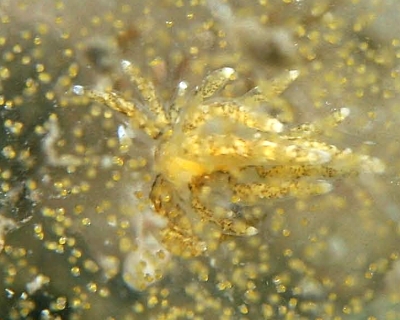
Dear Brian,
Thanks for the extra photo. As a rule of thumb, opisthobranchs don't produce egg masses much larger than themselves. Species of Favorinus produce a long thin egg string which is either arranged in a neat flat spiral or in a three-dimensional tangle. I am not sure, but I suspect if there is a flat surface they will lay a spiral but if not, they produce a tangle. There are photos of egg masses of F. tsuruganus [message #10739] and F. blianus [message #4710] on the Forum.
Best wishes,
Bill Rudman
Favorinus sp. 3 ? from East Timor
July 17, 2008
From: Brian Francisco
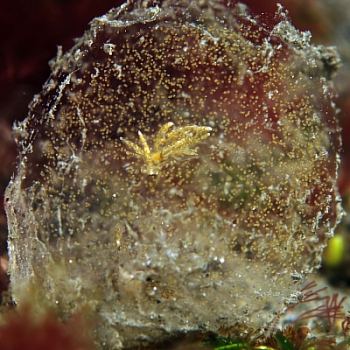
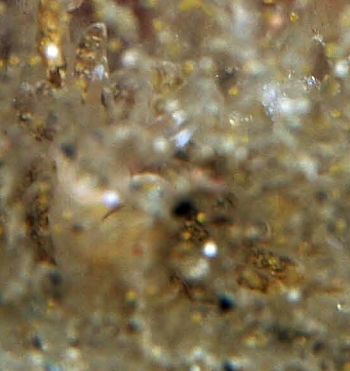
Hi Bill
This appears to be a Phyllodesmium that we found trapped with its eggs inside a mucus membrane. It may have no scientific relevance at all, but I couldn't resist sending it along.
Locality: Sandy Bottom, 14 metres, East Timor, Banda Sea, 13 July 2008, sandy slope. Length: 5 mm. Photographer: Brian Francisco.
Cheers
Brian
francisco.brian@gmail.com
Francisco, B., 2008 (Jul 17) Favorinus sp. 3 ? from East Timor. [Message in] Sea Slug Forum. Australian Museum, Sydney. Available from http://www.seaslugforum.net/find/21700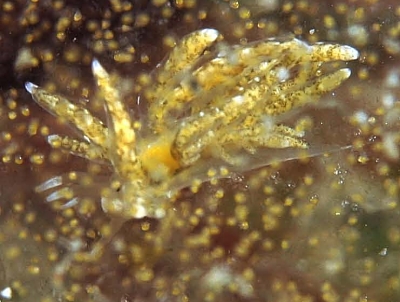
Dear Brian,
This is certainly an aeolid inside an egg mass but I think it is a bit big to be its own. I am pretty sure this is an aeolid which feeds on other opisthobranch's eggs. In the middle photo I have included a close-up to show a second, if somewhat obscured, specimen.
I suspect it is a species I am calling Favorinus sp. 3. However the main reason I am indentifying it as a species of Favorinus is because species of that genus feed on other sea slug eggs. It is possible when we look at its anatomy that it is not Favorinus, and that there is another group of aeolids feeding on this type of egg. Two other species on the Forum, Favorinus sp. 4 and Favorinus sp. 5, also have been found in opisthobranch egg masses.
Best wishes,
Bill Rudman
Re: Different egg masses eaten by Favorinus sp. 3
May 1, 2008
From: Cory Pittman
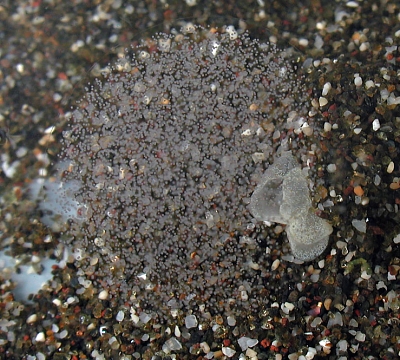
Concerning message #21547:
Dear Bill,
I agree that the elongate egg masses are aglajid. However, I wonder if the spherical egg masses in this and other messages might have been laid be haminoeids rather than polychaetes?
I've been holding Cephalaspidians in dishes for many years and quite a few have laid eggs for me. Although the genus Haminoea lays elongate egg masses that have spiral egg strings and adhesive surfaces, the genera Atys and Diniatys lay spherical masses that have randomly distributed eggs and are anchored by mucous strings. In two cases, I've caught them "in the act" and the envelope appears to be produced first, then the eggs are "blown" into it in small puffs inflating it like a balloon. Depending on species, the egg masses may be anchored in sand, algal turf or both. And, sand dwelling species may remain largely beneath the surface while laying. I've attached photos of two examples. The first shows a Diniatys laying an egg mass in one of my dishes. The animal was 10 mm in length and the egg mass 10.5 mm in diameter when finished. It was collected at a depth of less than 1 m at Hekili Point, Maui on October 5, 2002. The second shows an egg mass of Atys debilis. It was 8 mm in diameter. The animal was collected from between 14 m and 17 m at Black Rock, Maui on April 29, 2005. As you can see, they're very similar to some polychaete egg masses making it difficult to distinguish the two with certainty in the field or in photos.
Locality: Maui, Hawaii, Pacific. Photographer: Cory Pittman.
Best wishes,
Cory
cory@cet.com
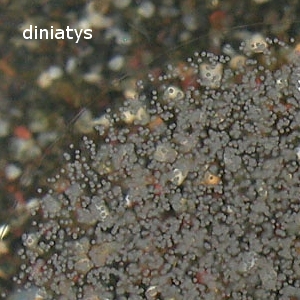
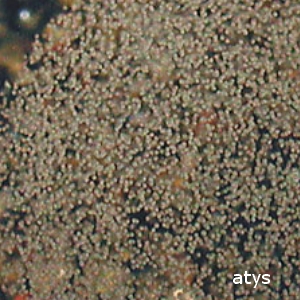
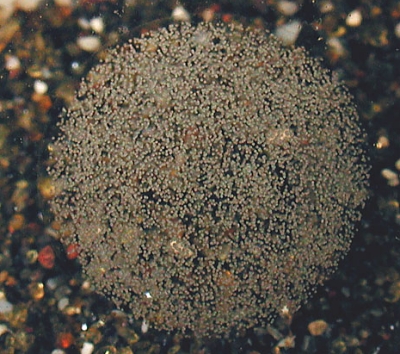
Dear Cory,
Thanks for these photos I agree distinguishing polychaete egg masses from those of cephalaspideans in the field or from photos is quite difficult. In the field I tend to go for rigidity - worm egg masses seem to be much 'floppier' - and egg size - worm eggs seem to be much smaller. But these are of course 'feelings' you pick up with experience and not really measurable. The only thing I can look for in photos is whether the eggs seem to be arranged in strings. As I am sure you know opisthobranch eggs are all linked together in a long chain, while eggs of those polychaetes that lay their eggs in mucous bags like this, are not linked together. I have included a close-ups of both your egg masses and am pretty sure that I can see strings of eggs in both cases which is what I would expect to see. However, as I can only see a few short strings, it's not a foolproof test.
If you feel like it, or have the time, it would be nice to have series of photos of the different egg masses you have observed.
Best wishes,
Bill Rudman
Several type of egg mass that Favorinus sp. 3 eat
April 30, 2008
From: Ayumi Murakami
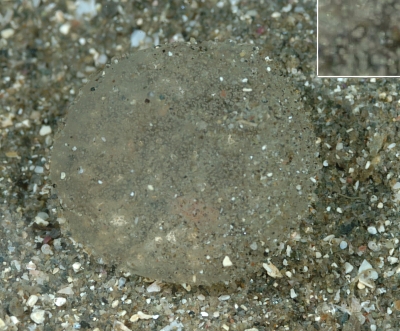
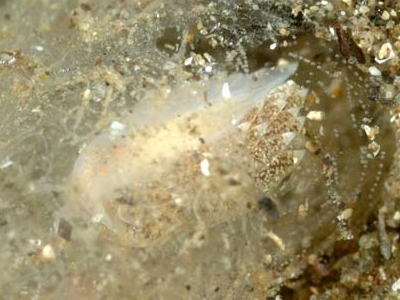
Concerning message #21545:
Dear Bill
Here are three photos of different egg masses which were being eaten by specimens of the aeolid mentioned in my last message [#21545 ].
Each egg mass has one or two animals inside them.
1.the shape is spherical and the eggs are scattered
2.it's oval shaped and the eggs are in strings
(My picture is just a part of the egg mass though)
3.the shape is cylindrical and the eggs are arranged in curved strings
These egg masses can be found on sandy bottoms in water 6-9 m deep and are about 15-2 0mm in length.
Locality: Futou beach,IZU.pen, 6-9m, Japan, Pacific Ocean, the 19th - the 20th of April 2008, muddy sand. Length: 3.5-8 mm. Photographer: Ayumi Murakami.
I guess more of the same species live there, because I observed five egg masses with the animals.
Best regards
Ayumi Murakami
umiushi2@masea.info
Ayumi Murakami, 2008 (Apr 30) Several type of egg mass that Favorinus sp. 3 eat. [Message in] Sea Slug Forum. Australian Museum, Sydney. Available from http://www.seaslugforum.net/find/21547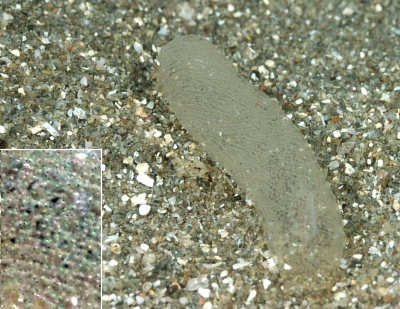
Dear Ayumi,
In an earlier message I said it looked as though this species feeds on polychaete worm eggs, and the spherical egg you have included here looks like that of a polychaete. However in the two elongate egg masses, as you describe, the eggs seem to be in strings which would seem to preclude a polychaete worm. Perhaps they are the eggs of a cephalaspid sea slug like Aglaja, Philinopsis or Philine?
Best wishes,
Bill Rudman
Egg-eating aeolids from Japan
April 30, 2008
From: Ayumi Murakami
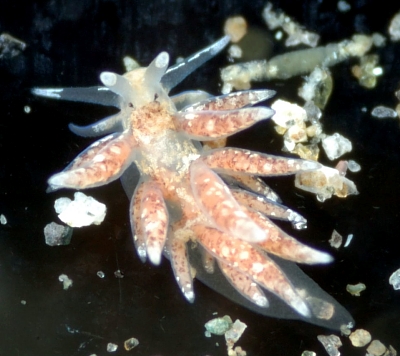
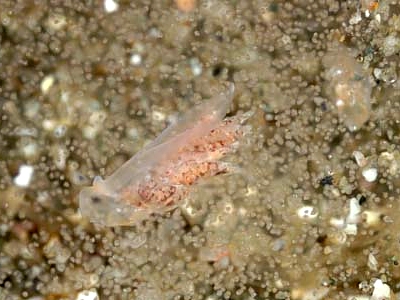
Concerning message #2846:
Dear Bill
I have observed aeolids inside of an unknown egg mass on the 19th-20th of April 2008 at Futou beach, Izu Peninsula in Japan.
One animal was 3.5mm in length and the biggest one was 8 mm both measured outside of egg mass. I have also found one in the sand about 2-4 cm under the surface.This species can go into the sand very quickly.
I am attaching three photos:
1. the 3.5mm length one
2. one inside an egg mass
3.the 8 mm length one was going into the sand
Do you think these animals are Favorinus?
I will send another message with pictures of different egg masses [#21547].
Locality: Futou Beach, Izu Peninsula, 6-9 m, Japan, Pacific Ocean, the 19 - 20;April 2008, muddy sand . Length: 3.5 mm, 8 mm. Photographer: Ayumi Murakami.
Ayumi Murakami
umiushi2@masea.info
Ayumi Murakami, 2008 (Apr 30) Egg-eating aeolids from Japan. [Message in] Sea Slug Forum. Australian Museum, Sydney. Available from http://www.seaslugforum.net/find/21545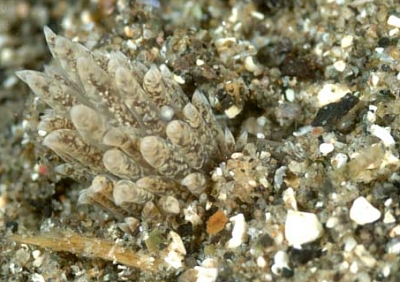
Dear Ayumi,
Thanks for these interesting photos. I am pretty sure they are Favorinus sp 3, which from previous reports seems to prefer eating polychaete worm eggs. Your close-up of the eggs suggests they are also polychaete eggs. There is the possibility this aeolid is not a Favorinus, as I know nothing of its anatomy. However since eggs are the main diet of species of Favorinus, it is a good guess to suggest it is a species Favorinus.
Best wishes,
Bill Rudman
Photos of an egg-eating aeolid
August 11, 2000
From: Terry Gosliner
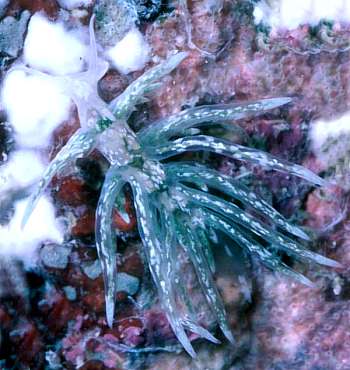
Dear Bill,
Here are the photos I promised of the egg-eating aeolid I have found which is the same as Denise's.
The lower right photo of the whole egg mass in from Anilao, Luzon Island, Philippines. The others are from Madang, Papua New Guinea.
The lower left photo shpws an animal crawling on the haminoeid egg mass. The inset shows the magnified egg ribbon of the aeolid. If you compare it with the other species I have sent photos of you will see that this species has a single row of eggs and the other has a double row.
Terry Gosliner
tgosline@CalAcademy.org
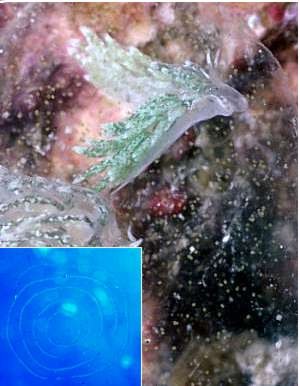
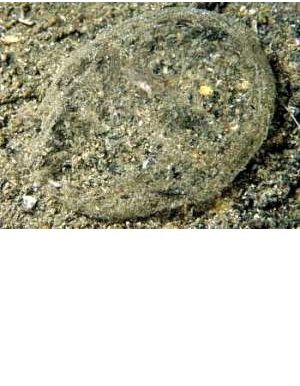
Thanks Terry,
Bill Rudman.
Re: egg-eating Favorinus
July 30, 2000
From: Terry Gosliner
Dear Bill,
Denise Nielsen Tackett's photos of the cephalaspidean egg eater brings back fond memories. There are actually two species of these Favorinus that we have found commonly in both Papua New Guinea and the Philippines. The other one not shown in Denise's photo has more inflated cerata. The two also have different shaped egg masses. I will dig out some photos of these guys and forward them to you. They are definitely exceptionally cool animals. The aeolids glide through the egg masses with their cerata held back close to the notum so they don't get tangled in the snot of the egg mass. Hey, it's a living!
All the best,
Terry.
tgosline@calacademy.org
Gosliner, T., 2000 (Jul 30) Re: egg-eating Favorinus. [Message in] Sea Slug Forum. Australian Museum, Sydney. Available from http://www.seaslugforum.net/find/2786Dear Terry,
Thanks for the graphic description of their life style. Look forward to seeing the photos.
Bill Rudman.
Re: egg-eating aeolids
July 28, 2000
From: Denise Nielsen Tackett
Dear Bill
Many thanks for your reply to my inquiry about the nudis in the egg cases. I will try to get a sample for you within the next few months and will also try to get some shots of the egg cases themselves.
Best Regards,
Denise
ldtackett@compuserve.com
Tackett, D.N., 2000 (Jul 28) Re: egg-eating aeolids. [Message in] Sea Slug Forum. Australian Museum, Sydney. Available from http://www.seaslugforum.net/find/2773Dear Denise,
Many thanks for your very interesting observation, which led to Clay & Patty Jo's messages on Favorinus? sp. 4 and Favorinus? sp. 5, two more aeolids with the same habit. You will also see they consider all the eggs eaten to be those of bubble shells, rather than my suggestion that they are worm eggs.
Best wishes,
Bill Rudman.
Nudibranchs inside egg cases
July 17, 2000
From: Denise Nielsen Tackett

I am a professional underwater photographer with a keen interest in marine life. Over the past five years I have dived mainly in Lembeh Strait in North Sulawesi, Indonesia and have seen and photographed something that interests and puzzles me. I am attaching 3 photos of egg cases (I think they are from worms or slugs) that have tiny nudibranchs inside them. The egg cases occur on sandy bottoms in very shallow water (3 - 20 meters deep). I have observed this over several years, mostly from July to December, but at other times as well. The egg cases seem to belong to different species because the egg pattern and sac shape differs slightly. Each sac seems to have several nudibranchs in it. The nudis are aeolids. Are they feeding on the eggs? Are there any nudis that do not have a veliger stage and hatch from egg cases like these?
Re the photos: UPPER RIGHT. Shows the entire sac/case with many nudis inside (size range 1-5mm long). The nudis are actually inside the sac that is why they are not super sharp - I'm shooting through the egg case. Can you shed any light on this for me. LOWER PHOTOS: Upper left - animals in egg case. Lower left - dorsal view of animal (approx 5mm long) on outside of egg case. Right - ventral view of animal (approx 2mm long) crawling on inside of egg case. White spots are polychaete eggs.
Many thanks,
Denise
ldtackett@compuserve.com
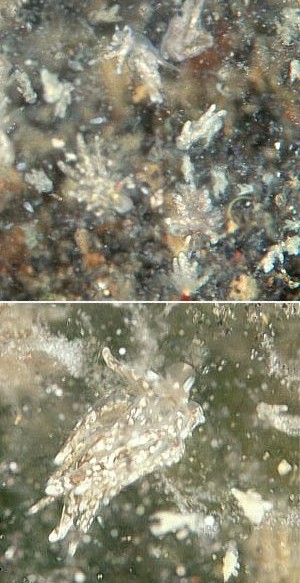
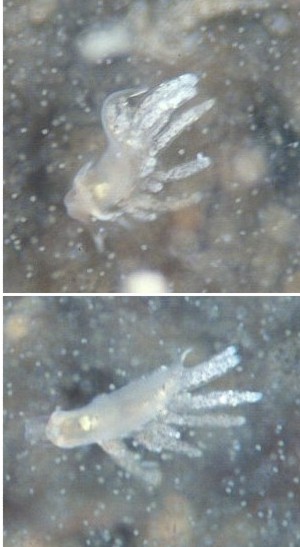
Dear Denise,
I have been waiting 30 years for some more of these animals to turn up. A fish biologist found these aeolids in a similar egg mass on the Great Barrier Reef in 1976. He also photographed their egg mass, attached to the inside of the one they were eating, and collected a carnivorous nudibranch of the genus Gymnodoris which was probably eating the aeolids. If he gives me permission, I will post his photos on the Forum.
Your animal is a species of Favorinus, a genus of aeolids which feed almost exclusively on eggs, usually of other sea slugs, but sometimes of snails. Have a look at the page on Favorinus japonicus for a typical species. In this case, their food is the eggs of a polychaete worm. The eggs are much smaller than those of an opisthobranch, and they do not seem to be in individual capsules.
One family of opisthobranchs which have a similar egg mass is the Aglajidae, which includes the tropical genera Chelidonura and Philinopsis, but in aglajids the eggs are in capsules and the capsules are linked together by a short string or chalaza. The eggs are arranged in a spiral within the egg sac. Have a look at Mary Jane Adam's photo of the egg masses of Chelidonura inornata.
I look forward to seeing some specimens,
Best wishes,
Bill Rudman.
